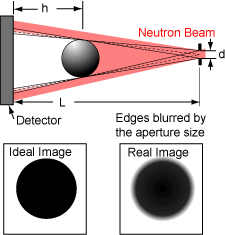Image Resolution: Geometric Blur
 While the detector resolution plays a big role in determining the image
resolution, one must always remember that geometry also limits the image
resolution. The geometric blur is illustrated in the cartoon to the right.
Imagine that the ball is perfectly opaque to neutrons, and so its image should
be a round, sharp shadow. However, since the ball is not directly in contact
with the detector, its edges do not uniformly block all the neutrons coming
from the entire aperture. Instead, some squeak by, causing the edge to be
blurred. If the ball (or an edge) could be placed directly in contact
with the detector surface, the resolution would be just that of the detectorís
intrinsic resolution. But, since there is always some displacement, h, between
the object and detector surface, there will always be some blur. The geometric
resolution, λ is approximately given by:
While the detector resolution plays a big role in determining the image
resolution, one must always remember that geometry also limits the image
resolution. The geometric blur is illustrated in the cartoon to the right.
Imagine that the ball is perfectly opaque to neutrons, and so its image should
be a round, sharp shadow. However, since the ball is not directly in contact
with the detector, its edges do not uniformly block all the neutrons coming
from the entire aperture. Instead, some squeak by, causing the edge to be
blurred. If the ball (or an edge) could be placed directly in contact
with the detector surface, the resolution would be just that of the detectorís
intrinsic resolution. But, since there is always some displacement, h, between
the object and detector surface, there will always be some blur. The geometric
resolution, λ is approximately given by:
λ = d h / L.
For instance, with an L/d of 300, and a separation h = 10 cm,
the geometric resolution is about 0.33 mm. Another interpretation of the
geometric resolution is to imagine placing a pinhole at the objectís location.
The geometric resolution is then the size of the minified aperture on the
detector, which from similar triangles is simply:
λ = d h / (L >> h).
By assuming that L >> h, one arrives at the approximate formula.
Inquiries or comments:
David
Jacobson
Online: May 2006
|


